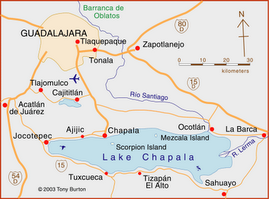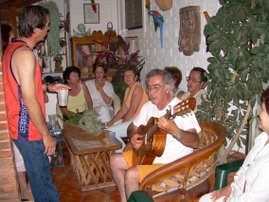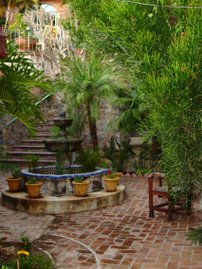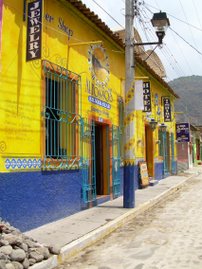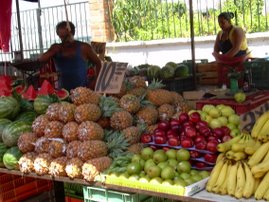Living in Maine, we really had very little experience knowing Mexican people. As we all know so well, many Mexicans are poor. Manual laborers in Mexico earn an average of $300 per month, while professionals earn an average of about $1000 per month. These are averages. Some earn more, some earn less. One of our primary concerns about moving to a community with lots of "Nortamericanos" was that there was bound to be a big divide between us and the Mexicans. I was concerned that there would be resentment towards us because of the fact that we are here with money to spend, in stark contrast to most Mexicans.
We have been very happy that most Mexicans are extremely friendly and courteous. I am sure there are some resentments; it is inevitable. But by and large, they seem to accept having us here and appreciate the fact that our presence is creating lots of jobs in this area of Mexico. We are living on the West side of town, which is predominantly Mexican, so we have regular contact with many local people. As we would expect, they like it when we speak Spanish and they are very helpful when we don't know the correct word to use. They often go out of their way to help us find what we are looking for. And, of course, they all seem to like Maggie who transcends the language barrier.
The Mexican people we have known and observed work very hard. We have a couple of men working on a roof next door. Now this roof is made up of flat tiles cemented onto a cement roof. It took them over a week to pick axe the old roof off. Now they are mixing cement and putting the new tiles on the roof. It is hot, exhausting work. We've been bringing them ice tea every day, and they are very appreciative. These guys work very hard, but they seem happy and content. We often hear them laughing and even singing as they work. We try to make jokes in Spanish, but I think I usually confuse them. But they are polite and laugh anyway.
We have a young couple, Antonio and his wife Claudia, who take care of the six cottages in our compound. In exchange for a very small casita and $300 a month, Antonio is the caretaker/gardener for the houses, and Claudia cleans all the houses once a week. They are always around and very helpful. I needed to order a new tank of gas to have it delivered, but the people at the gas company only spoke Spanish, so Claudia called and ordered the gas for me. Antonio carried the Buddha in from the car for me and is going to weld a small grate to fix up our charcoal grill so we can use it. They both speak excellent English and politely correct us when we mispronounce Spanish words. It would probably be easier for them if we just spoke English, but they are happy to try to figure out what we are trying to say in Spanish.
Clearly, the most important characteristic of the Mexican people is their devotion to family. Although many Mexicans have family members who have gone to the United States to work, their dream is to come back to Mexico and be with their families. Their lives are not defined by their work, as ours tends to be in the US. They work to live, of course, but they will not give up family holiday time to work, even if they can earn extra money. They are used to making ends meet and I do not think money is the central focus of their lives. This family orientation is evident in their attitude towards their children. You often see tough, macho Mexican men tenderly carrying infants in the plaza or in front of their homes. Mothers always meet their children after school, buy them a sweet snack, and walk them home, carrying their backpacks for them. The children here seem remarkably well behaved. They have little, but they clearly feel loved and treasured.
Although we have not run into any serious problems on the road, a number of our friends here have related stories in which they were stuck in the middle of nowhere, either because of an accident or mechanical problems, and people have immediately stopped to offer help, transportation, food, even a bed for the night, often at their own personal inconvenience. I have yet to hear of any banditos! The culture here, in one sense, reminds me of Italy. Although it is much less formal, and there is less prosperity here, the Mexicans have the same high standard of hospitality. You can sit in a restaurant all night if you choose. You will not be offered the check until you request, "La cuenta, por favor." It is a very civil and polite culture. Although I have noticed that there is a generational difference here. The older Mexicans tend to be more strict about this. Although many younger Mexicans are very open and helpful, some are clearly less so. Things are changing in Mexico as in the US. As more prosperity comes to Mexico, their culture will likely change even more, perhaps to become more like the US. Hmmmmmm.
Sunday, June 24, 2007
Wednesday, June 20, 2007
Some Interesting Things about Living in Mexico
Well it had to happen sometime...I committed a traffic violation and got busted. I was coming out of the big Mexican department store, Sorianas, and trying to get back to the town of Chapala. Although there is a clearly marked, "no left turn" symbol on a sign as you come out of the driveway, a friend had told me that they don't "enforce" it, and, indeed, I have seen many others go out that way. Well, of course, when I tried it last Saturday, after having done it successfully several times before, I was pulled over by a municipal "Policia." He was very nice and explained in broken English how I should go out around another way. I was very polite and thanked him for the information.
Then, he pulled out his pad and said, "But, Senor, I have to give you a ticket for this."
"Okay," I replied. "How much will the ticket cost?"
"Two hundred pesos." (About $20).
Now, I remembered several people telling me that if you get a ticket, they may take your American drivers license and you will supposedly get it back once you pay the ticket. I was not anxious to give up my drivers license, but I replied, "OK. Then I guess I get a ticket."
He looked at me and waited. He was not writing anything. This was, it became obvious, the time for me to offer to pay him instead. I did not want to encourage corruption, yet I also did not want to lose my license. I understand that these local police officers make very little money, and this is a way they supplement their income. After a quick internal ethical debate, I caved.
"So, Senor," I asked, "Could you pay the ticket for me?"
"Si."
I thought later I should have told him I only had 100 pesos, but instead I dutifully produced a 200 peso note, whereupon, he politely returned my license. I had paid my first "mordida." I had come of age as a gringo in Mexico!
Driving, in general, is a bit more challenging here. Traffic laws seem to be more "suggestions" than laws, at least for the Mexicans. I get the feeling that driving a foreign-plated car in Mexico puts you at more risk of getting pulled over. Mexicans seem to violate the ridiculously low speed limits in some areas. I try to follow the limits, but the Mexicans whiz by me when I do. I feel like an old feeble driver driving so slow, but I don't want to get pulled over either. So, I try to keep up with traffic, within limits. I often see Mexican drivers, usually young men, take great risks in passing on hills and such. We frequently see a pickup truck full of young children in the bed of the truck, sometimes sitting on the edge of the body. Someone mentioned that their deep faith, and perhaps fatalism, leads them to put their lives "in God's hands." I do see evidence of this.
We went to a fiesta last week in the neighboring town. At about midnight each night, they set off amazing fireworks on a wooden scaffold with spinning wheels, rockets, and even animated moving contraptions (we saw a butterfly flapping its fiery wings). They make absolutely no attempt to clear people away from the fireworks scaffold before they light it. The general rule in Mexico seems to be, "Pay attention. You are responsible for yourself." It's just very different from the US where we are constantly being "protected" from our own bad judgment by laws and regulations. No OSHA here!
Finding what you need here is probably much easier now than it may have been a decade ago, but there are still a few challenges. Good black tea is difficult to find unless you go to expensive import stores and buy small boxes of Bigelow tea, or some other expensive brand. We prefer Tetley's British Blend, which is nowhere to be found here. We'll have to stock up on that on visits home. Herbal tea, on the other hand, is plentiful and cheap. You can buy a box of 100 tea bags of chamomile, peppermint, spearmint or lemon tea for about 30 pesos, about $3. Also, no good microbrew beer here; everything is a lager, like Corona. They have a couple of darker lagers I do like: Negro Modela, and Indio. There IS peanut butter here, after all, cheaper than I thought: about 25 pesos.
Finding reading material is always a challenge. The stores do sell a weekly English-language newspaper here, The Guadalajara Reporter. There a re a couple of English language magazines here, The Lake Chapala Review and Ojo del Lago (Eye of the Lake), published by and for the gringo population. Used English-language books are sold at the Ajijic weekly market, but they are never very good, and the same ones every week. The best option is the Lake Chapala Society library, which has about 20,000 English books. I now read my favorite newspapers and magazines on line.
We are venturing into Guadalajara tomorrow to see what we find! That should be an interesting drive. We drove in last week with a friend who knew where he was going to navigate. We're going tomorrow on our own.
Last night it rained all night, very hard, and we awoke to two big leaks in the house. Glad we are renting! No one knows how many leaks they have until the rainy season starts. I think it has started in earnest. I imagine people are discovering new leaks all over town! It's nice and cool here now.
I've posted a few photos to go with this post, but not many. Let's see what adventures another week or so brings!
Then, he pulled out his pad and said, "But, Senor, I have to give you a ticket for this."
"Okay," I replied. "How much will the ticket cost?"
"Two hundred pesos." (About $20).
Now, I remembered several people telling me that if you get a ticket, they may take your American drivers license and you will supposedly get it back once you pay the ticket. I was not anxious to give up my drivers license, but I replied, "OK. Then I guess I get a ticket."
He looked at me and waited. He was not writing anything. This was, it became obvious, the time for me to offer to pay him instead. I did not want to encourage corruption, yet I also did not want to lose my license. I understand that these local police officers make very little money, and this is a way they supplement their income. After a quick internal ethical debate, I caved.
"So, Senor," I asked, "Could you pay the ticket for me?"
"Si."
I thought later I should have told him I only had 100 pesos, but instead I dutifully produced a 200 peso note, whereupon, he politely returned my license. I had paid my first "mordida." I had come of age as a gringo in Mexico!
Driving, in general, is a bit more challenging here. Traffic laws seem to be more "suggestions" than laws, at least for the Mexicans. I get the feeling that driving a foreign-plated car in Mexico puts you at more risk of getting pulled over. Mexicans seem to violate the ridiculously low speed limits in some areas. I try to follow the limits, but the Mexicans whiz by me when I do. I feel like an old feeble driver driving so slow, but I don't want to get pulled over either. So, I try to keep up with traffic, within limits. I often see Mexican drivers, usually young men, take great risks in passing on hills and such. We frequently see a pickup truck full of young children in the bed of the truck, sometimes sitting on the edge of the body. Someone mentioned that their deep faith, and perhaps fatalism, leads them to put their lives "in God's hands." I do see evidence of this.
We went to a fiesta last week in the neighboring town. At about midnight each night, they set off amazing fireworks on a wooden scaffold with spinning wheels, rockets, and even animated moving contraptions (we saw a butterfly flapping its fiery wings). They make absolutely no attempt to clear people away from the fireworks scaffold before they light it. The general rule in Mexico seems to be, "Pay attention. You are responsible for yourself." It's just very different from the US where we are constantly being "protected" from our own bad judgment by laws and regulations. No OSHA here!
Finding what you need here is probably much easier now than it may have been a decade ago, but there are still a few challenges. Good black tea is difficult to find unless you go to expensive import stores and buy small boxes of Bigelow tea, or some other expensive brand. We prefer Tetley's British Blend, which is nowhere to be found here. We'll have to stock up on that on visits home. Herbal tea, on the other hand, is plentiful and cheap. You can buy a box of 100 tea bags of chamomile, peppermint, spearmint or lemon tea for about 30 pesos, about $3. Also, no good microbrew beer here; everything is a lager, like Corona. They have a couple of darker lagers I do like: Negro Modela, and Indio. There IS peanut butter here, after all, cheaper than I thought: about 25 pesos.
Finding reading material is always a challenge. The stores do sell a weekly English-language newspaper here, The Guadalajara Reporter. There a re a couple of English language magazines here, The Lake Chapala Review and Ojo del Lago (Eye of the Lake), published by and for the gringo population. Used English-language books are sold at the Ajijic weekly market, but they are never very good, and the same ones every week. The best option is the Lake Chapala Society library, which has about 20,000 English books. I now read my favorite newspapers and magazines on line.
We are venturing into Guadalajara tomorrow to see what we find! That should be an interesting drive. We drove in last week with a friend who knew where he was going to navigate. We're going tomorrow on our own.
Last night it rained all night, very hard, and we awoke to two big leaks in the house. Glad we are renting! No one knows how many leaks they have until the rainy season starts. I think it has started in earnest. I imagine people are discovering new leaks all over town! It's nice and cool here now.
I've posted a few photos to go with this post, but not many. Let's see what adventures another week or so brings!
Saturday, June 9, 2007
The Village of Ajijic
The village of Ajijic is the center of the expatriate population on Lake Chapala, although hardly the only village around the Lake Chapala and Guadalajara area where many Americans, Canadians and Europeans have settled. As you can see from the map, Ajijic is one of several towns on the north shore of Lake Chapala, Mexico's largest fresh water lake. The two closest towns, Chapala and Jocotepec have fewer Nortamericanos, but there is clearly more development headed in those directions. Chapala is much larger than Ajijic, and Mexicans have come for years to vacation at its lake front.
Ajijic has been the center of expartiate settlement in this area for decades. It attracted a lot of artists and writers, and the village still feels this influence. There are many art galleries and shops. Tennessee Williams, Somerset Maugham, and D.H. Lawrence all lived and wrote in the Ajijic area.
The streets remain rough cobblestone, except for the "Carretera" which runs between the towns. The population of Ajijic is estimated at about 15,000, with about 3-4,000 full time expatriate residents. Even though the expatriate residents have brought money into the area, and driven prices up, many of the Mexican families have stayed in Ajijic. In fact, Mexicans are probably drawn to the area because of the work opportunities created by the influx of "gringos." By the way, the term gringo first came as a nickname for the American soldiers who occupied Mexico during the Mexican American war and was, of course, a pejorative term. Today, the term appears to be more neutral; we hear Mexicans refer to their "gringo friends" and well as "dumb, arrogant gringos," a moniker we are trying to avoid!
The village is dominated by the lake on the south side, and beautiful mountains on the north side. The north, or mountain side, of the Carretera, was, until recently undeveloped. The lake side contains the old village. The mountain side has now been developed with a number of gated communities designed exclusively for gringo retirees. These homeowners, building up the mountainside, have beautiful lake views, but live isolated from their Mexican neighbors.
We live on the west side of Ajijic, on the lake side, an area that is primarily Mexican. Many Guadaljarans own lakeside cottages on the lake. Our casita is in a group of six such cottages which have been owned for use on weekends. Four of these are owned by Mexicans and the other two by gringos, one of which we rent. Saturday night when we came back from dinner to celebrate our 33rd anniversary, a family of Mexicans in one of the other cottages invited us to visit with them. We enjoyed their company and had a good opportunity to work on our Spanish; they spoke very little English.
As you might imagine, there is quite a bit of building going on in Ajijic. Most of it is being done by hand, very slowly. The overall sense you get when walking or driving around the area is that people everywhere are selling food, crafts, and just about anything they can make pesos with. I think Mexicans love to eat, and there are opportunities everywhere to find food. Many families own small tiendas, or shops, which are very tiny and sell food, clothes, beer, tortillas, or other useful items. They live in the back, and it provides the family with an income. The Caraterra is full of businesses and restaurants and has a bit of a chaotic feel to it. Mexico is not a quiet place! There is litter and graffiti. They don't seem to have any zoning or development laws here. You might see a nice new restaurant next to an empty lot with goats, next to an auto repair shop, next to a boutique. But it is full of people of all types living their lives, peacefully and courteously.
Overall, Ajijic is an interesting mix of pure Mexican life and gringo amenities. We often see our Mexican neighbors riding horses through town, herding cows down by the lake, or cooking corn to sell on their front stoop, while, at the same time, the town has at least 50 restaurants of all types and prices, wireless high speed internet access, cable and satellite TV, and many other services the gringo retirees seek.
I do worry about where this is all headed, as more boomers retire here, which is one reason we are renting here instead of buying. But, for now, it's a very pleasant combination of authentic Mexican culture, comfortable living, stupendous lake and mountain views, tropical birds and, of course, beautiful weather.
Ajijic has been the center of expartiate settlement in this area for decades. It attracted a lot of artists and writers, and the village still feels this influence. There are many art galleries and shops. Tennessee Williams, Somerset Maugham, and D.H. Lawrence all lived and wrote in the Ajijic area.
The streets remain rough cobblestone, except for the "Carretera" which runs between the towns. The population of Ajijic is estimated at about 15,000, with about 3-4,000 full time expatriate residents. Even though the expatriate residents have brought money into the area, and driven prices up, many of the Mexican families have stayed in Ajijic. In fact, Mexicans are probably drawn to the area because of the work opportunities created by the influx of "gringos." By the way, the term gringo first came as a nickname for the American soldiers who occupied Mexico during the Mexican American war and was, of course, a pejorative term. Today, the term appears to be more neutral; we hear Mexicans refer to their "gringo friends" and well as "dumb, arrogant gringos," a moniker we are trying to avoid!
The village is dominated by the lake on the south side, and beautiful mountains on the north side. The north, or mountain side, of the Carretera, was, until recently undeveloped. The lake side contains the old village. The mountain side has now been developed with a number of gated communities designed exclusively for gringo retirees. These homeowners, building up the mountainside, have beautiful lake views, but live isolated from their Mexican neighbors.
We live on the west side of Ajijic, on the lake side, an area that is primarily Mexican. Many Guadaljarans own lakeside cottages on the lake. Our casita is in a group of six such cottages which have been owned for use on weekends. Four of these are owned by Mexicans and the other two by gringos, one of which we rent. Saturday night when we came back from dinner to celebrate our 33rd anniversary, a family of Mexicans in one of the other cottages invited us to visit with them. We enjoyed their company and had a good opportunity to work on our Spanish; they spoke very little English.
As you might imagine, there is quite a bit of building going on in Ajijic. Most of it is being done by hand, very slowly. The overall sense you get when walking or driving around the area is that people everywhere are selling food, crafts, and just about anything they can make pesos with. I think Mexicans love to eat, and there are opportunities everywhere to find food. Many families own small tiendas, or shops, which are very tiny and sell food, clothes, beer, tortillas, or other useful items. They live in the back, and it provides the family with an income. The Caraterra is full of businesses and restaurants and has a bit of a chaotic feel to it. Mexico is not a quiet place! There is litter and graffiti. They don't seem to have any zoning or development laws here. You might see a nice new restaurant next to an empty lot with goats, next to an auto repair shop, next to a boutique. But it is full of people of all types living their lives, peacefully and courteously.
Overall, Ajijic is an interesting mix of pure Mexican life and gringo amenities. We often see our Mexican neighbors riding horses through town, herding cows down by the lake, or cooking corn to sell on their front stoop, while, at the same time, the town has at least 50 restaurants of all types and prices, wireless high speed internet access, cable and satellite TV, and many other services the gringo retirees seek.
I do worry about where this is all headed, as more boomers retire here, which is one reason we are renting here instead of buying. But, for now, it's a very pleasant combination of authentic Mexican culture, comfortable living, stupendous lake and mountain views, tropical birds and, of course, beautiful weather.
Saturday, June 2, 2007
Our Mexican Home: We're Not in Kansas Anymore!
We've moved into our Mexican casa at last! Actually living here is wonderful, yet I can tell we will have to acclimate to living in a different climate and a different culture. In this post, I'll show you our new home and discuss some of the differences between this home and the kind of homes we're used to.
First of all, Mexican houses are constructed entirely differently. They use very little wood, except for trim, because of termites. The houses are constructed of brick and concrete, and many interior surfaces are ceramic tile. I am so used to worrying about water damage, ice dams, etc, that I like the idea of everything made out of tile so if the roof leaks, no big problems. Our house has dark blue tile throughout, including on the two patios. The kitchen and bathrooms have old handmade tiles on the wall surfaces. In this area of Mexico they build brick "Boveda" ceilings which are arched for stability. Overall the houses have a different look, and are easy easy to keep clean. The floors are obviously hard and less "giving" than wood floors. But no vacuuming, just sweep and damp mop.
Most houses here are made to accommodate outdoor living. We have the two patios, but many homes have entire open garden spaces within the walls of the home. Restaurants are the same way. That is a very different and appealing concept to us Mainers who must have a clear differentiation between inside and outside! There are few bugs now, but in the rainy season, I am told, we will get mosquitoes until the dry season returns in October. No black flies, but swarms of "bobos" At least they don't bite. I haven't seen any scorpions yet.
One reason we didn't bring any furniture with us is (besides the cost of moving it) that the furniture here is different. Because of the dry climate, our New England furniture's wood joints would dry up and come loose. Plus, it would look out of place in Mexican houses. The two types of furniture I see in most Mexican homes are rough carved rustic wooden tables and chairs (like the colorful ones they have at Margarita's in Lewiston), and leather Equipal furniture, native to this area of Mexico, made from wood, leather, and cactus fibers. It's comfortable, but, as you can see, it looks totally different from any other furniture. Mexican beds are hard; they don't use box springs. We got a thick matress pad to bring with us, and it's not bad.
Mexican plumbing is not like the US. HaHa. First of all, you can't drink the tap water, not because the water is polluted, but because the way it's transported and stored, often on tanks on the roofs of the houses, it can develop bacteria. Our house has a ultraviolet purification system on it (which can be purchased for about $800 USD), which make all the water in our house safe for drinking. We have bottled water to use during power failures, but we drink the tap water and it tastes good. Mexican homes have little gas hot water heaters which produce limited hot water. The pressure is often low, but it's great in our house. The water doesn't get scalding hot, but hot enough. Now here's the delicate part: Mexican toilets generally don't do well with toilet paper because the pipes have lots of right angle elbows. TP clogs up the system. So in most Mexican homes (ours included) used TP is folded neatly and put in a special covered trash receptacle and emptied every few days. It does not smell and is easy, once you get used ot the idea. Really!!!
Because the climate is so temperate, the houses in this area of Mexico have no central heating system. We have small fireplaces in the living room and bedroom which can provide heat during the colder winter nights with temps in the 40's. Because the houses are made of concrete and brick, they have little insulation from the cold, and temps in the 40's can seem quite cold. So we need heavy blankets for the middle of winter. During the day, the temps rise to the 70's though. Although it would be nice during this time of year, there is generally no AC. We have four ceiling fans, and if we close the curtains and keep the fans on, it's not too bad in the hot part of the day.
Electricity here is reasonable, but the cost per kwh rises as you use more. So if you cross a threshold of electricity use, your rate goes up for all the electricity you use. By not having a dishwasher or dryer we hope our bills are not too high. We also lose power or partial power frequently. People here just deal. I think that's why everyone has gas stoves. This morning our ceiling fan slowed way down. We thought, "Oh, no. It's broken." But it was just a brownout. The electricity waxes and wanes a bit. We need to have voltage regulators on our electronic gear to prevent damage. After about an hour, the fan was working fine again. When I mentioned it to some UU friends at church this morning, they said it's a fairly common occurrence.
So....living here has its challenges as well as its rewards. Pixie is feeling better already. We are spending lots of great time together. We have our Vonage phone hooked up, and it works great, so you can call us at our old Auburn number 783-3900. I will try to think of interesting things to write about Mexico and post to this blog every week or two.
First of all, Mexican houses are constructed entirely differently. They use very little wood, except for trim, because of termites. The houses are constructed of brick and concrete, and many interior surfaces are ceramic tile. I am so used to worrying about water damage, ice dams, etc, that I like the idea of everything made out of tile so if the roof leaks, no big problems. Our house has dark blue tile throughout, including on the two patios. The kitchen and bathrooms have old handmade tiles on the wall surfaces. In this area of Mexico they build brick "Boveda" ceilings which are arched for stability. Overall the houses have a different look, and are easy easy to keep clean. The floors are obviously hard and less "giving" than wood floors. But no vacuuming, just sweep and damp mop.
Most houses here are made to accommodate outdoor living. We have the two patios, but many homes have entire open garden spaces within the walls of the home. Restaurants are the same way. That is a very different and appealing concept to us Mainers who must have a clear differentiation between inside and outside! There are few bugs now, but in the rainy season, I am told, we will get mosquitoes until the dry season returns in October. No black flies, but swarms of "bobos" At least they don't bite. I haven't seen any scorpions yet.
One reason we didn't bring any furniture with us is (besides the cost of moving it) that the furniture here is different. Because of the dry climate, our New England furniture's wood joints would dry up and come loose. Plus, it would look out of place in Mexican houses. The two types of furniture I see in most Mexican homes are rough carved rustic wooden tables and chairs (like the colorful ones they have at Margarita's in Lewiston), and leather Equipal furniture, native to this area of Mexico, made from wood, leather, and cactus fibers. It's comfortable, but, as you can see, it looks totally different from any other furniture. Mexican beds are hard; they don't use box springs. We got a thick matress pad to bring with us, and it's not bad.
Mexican plumbing is not like the US. HaHa. First of all, you can't drink the tap water, not because the water is polluted, but because the way it's transported and stored, often on tanks on the roofs of the houses, it can develop bacteria. Our house has a ultraviolet purification system on it (which can be purchased for about $800 USD), which make all the water in our house safe for drinking. We have bottled water to use during power failures, but we drink the tap water and it tastes good. Mexican homes have little gas hot water heaters which produce limited hot water. The pressure is often low, but it's great in our house. The water doesn't get scalding hot, but hot enough. Now here's the delicate part: Mexican toilets generally don't do well with toilet paper because the pipes have lots of right angle elbows. TP clogs up the system. So in most Mexican homes (ours included) used TP is folded neatly and put in a special covered trash receptacle and emptied every few days. It does not smell and is easy, once you get used ot the idea. Really!!!
Because the climate is so temperate, the houses in this area of Mexico have no central heating system. We have small fireplaces in the living room and bedroom which can provide heat during the colder winter nights with temps in the 40's. Because the houses are made of concrete and brick, they have little insulation from the cold, and temps in the 40's can seem quite cold. So we need heavy blankets for the middle of winter. During the day, the temps rise to the 70's though. Although it would be nice during this time of year, there is generally no AC. We have four ceiling fans, and if we close the curtains and keep the fans on, it's not too bad in the hot part of the day.
Electricity here is reasonable, but the cost per kwh rises as you use more. So if you cross a threshold of electricity use, your rate goes up for all the electricity you use. By not having a dishwasher or dryer we hope our bills are not too high. We also lose power or partial power frequently. People here just deal. I think that's why everyone has gas stoves. This morning our ceiling fan slowed way down. We thought, "Oh, no. It's broken." But it was just a brownout. The electricity waxes and wanes a bit. We need to have voltage regulators on our electronic gear to prevent damage. After about an hour, the fan was working fine again. When I mentioned it to some UU friends at church this morning, they said it's a fairly common occurrence.
So....living here has its challenges as well as its rewards. Pixie is feeling better already. We are spending lots of great time together. We have our Vonage phone hooked up, and it works great, so you can call us at our old Auburn number 783-3900. I will try to think of interesting things to write about Mexico and post to this blog every week or two.
Subscribe to:
Posts (Atom)
